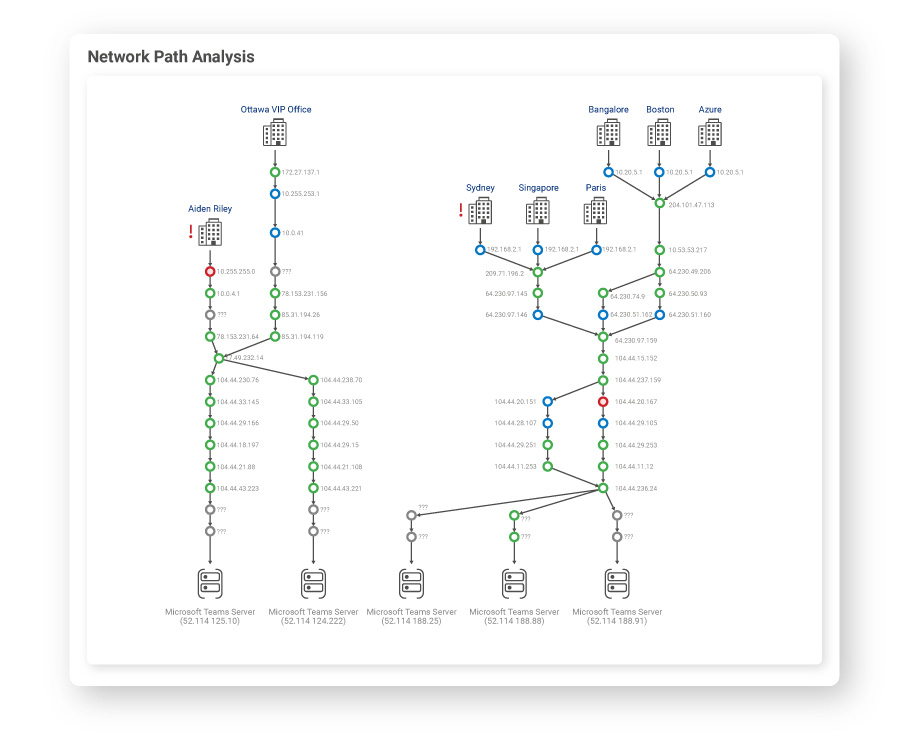See more, solve more with end-to-end network path tracing
Microsoft Teams Monitoring
Few things hold IT teams back more than a lack of visibility. It’s exponentially harder to solve issues when they originate in parts of the environment you can’t see.
That’s one of the big limitations of native tools for monitoring and managing Microsoft Teams.
Microsoft Call Quality Dashboard, Admin Center and Service Dashboard, and Meeting Room Pro Dashboard are all constrained to the aspects of Teams that Microsoft controls directly. Excluded from that are any ISP or local networks involved in a Teams session. Yet more than 60% of Teams issues arise in those networks.
Martello’s Vantage DX sheds light into the places native tools can’t reach with end-to-end network path tracing.
See trouble spots faster with network path tracing
Vantage DX can trace and visualize any Teams session. That includes live sessions involving real users and synthetic tests {link to synthetic testing blog} carried out in the background by automated bots to proactively probe network performance without users involved.
Data from native Microsoft tools is correlated with Vantage DX’s built-in monitoring capabilities to compile a full picture of the Teams environment from the data center through the network to end user devices and meeting rooms. All network segments are clearly marked, with every node identified by IP address.

Network path tracing in Vantage DX makes it easy to see your entire Teams ecosystem at a glance.
If any part of the environment isn’t performing as it should — outside of baseline Microsoft thresholds or custom parameters you’ve set to track — the specific element affected is indicated in red.
Get to the source
Because Vantage DX identifies the IP address of each node and who owns the network segment it sits in, when there’s a problem identified with network path tracing you can respond with precision. You can see clearly if the issue is occurring in the Microsoft data center, in the wider network — even in a remote user’s wifi network.
If the issue is inside your own network domain — designated as “private use network” in Vantage DX — you can pinpoint exactly which element or elements are implicated, drill down into analytics to determine the root cause, and implement the fix.
If it’s an ISP network issue, such as traffic exceeding Microsoft’s 500 millisecond round-trip threshold, you can include the exact date, time and IP address of the affected node when you create a ticket. Having that detailed evidence in hand makes it much harder for third parties to deflect responsibility or assert the blame must lie with someone else, speeding up resolution by eliminating finger-pointing.
Your data, the way you need to see it with network path tracing
What you visualize in Vantage DX is up to you. Monitor key locations within your organization, track data by user group — such as particular business units or VIPs — and keep an eye on the specific performance of key assets or premium services such as Teams Room equipment or Teams Phone services.
The ability to trace end-to-end network paths not only for live traffic but also for synthetic tests means you can take a more proactive approach to managing the Teams experience. Issues that surface through synthetic testing can be resolved before users are affected, maintaining the service levels your organization demands.
For busy IT teams carrying the weight of high user expectations, being able to see issues at a glance — in the big picture context of the entire Teams environment — is a game-changer, streamlining and speeding up troubleshooting with precise, objective data.
If you’d like to learn more about network path tracing in Vantage DX and see it in action, book a demo with our team today.


